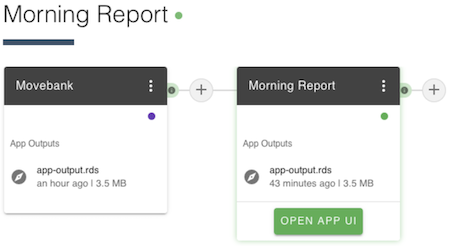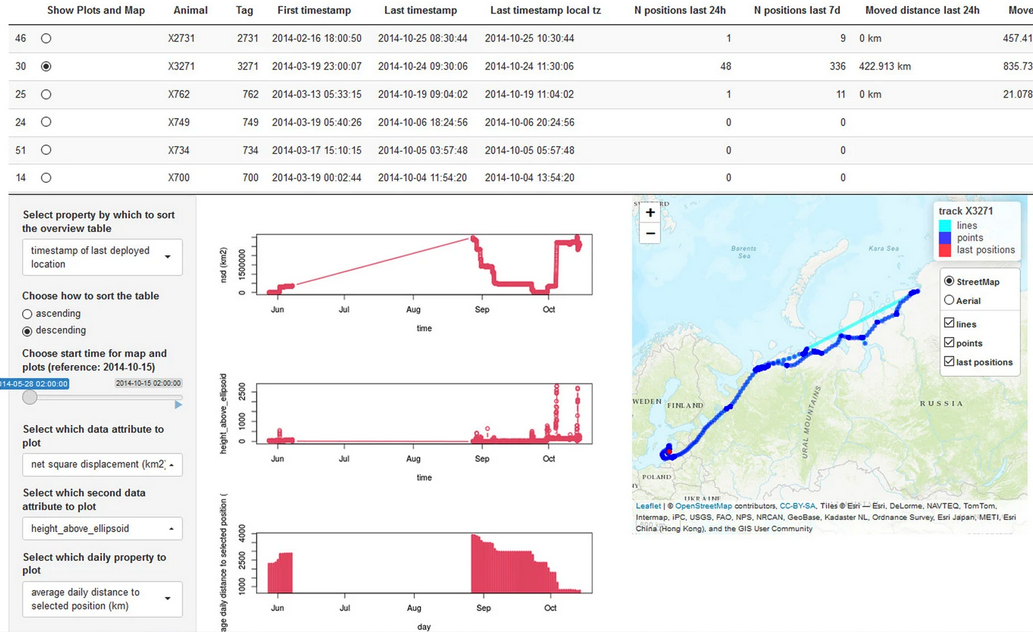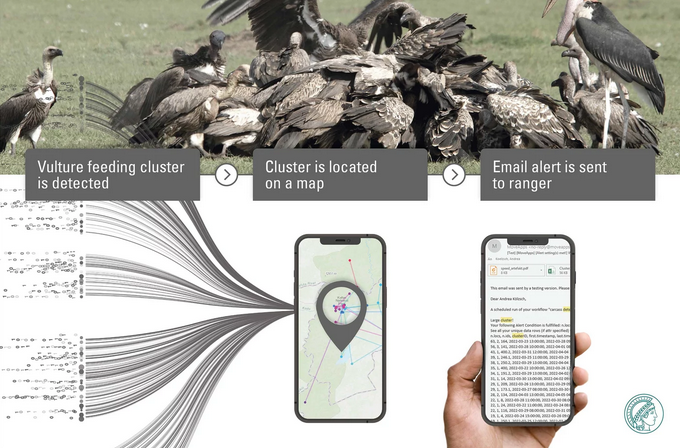Introducing cutting-edge analysis with MoveApps
As Movebank has grown, we have received many requests to build advanced mapping and analysis tools on the website. However, with so many analysis methods advancing so quickly, there was no way we could keep up—unless we found a way to allow open-source development and community contributions. After years of planning, we recently released MoveApps, a no-code analysis platform developed by the Max Planck Institute of Animal Behavior (MPI-AB) that allows Movebank users to easily process, visualize, and analyze their animal tracking data. Read our recent paper in Movement Ecology describing the platform and how it can address common analysis needs.
By providing a user-friendly interface and bypassing the need to know command-line programming, MoveApps allows you to interactively create and share workflows composed of analysis modules (Apps), each with settings that can be customized for your data or species of interest. Like Lego blocks, Apps are pieced together into workflows, effectively converting a complex analysis into a few simple clicks. For example, a workflow might consist of one App to read the data, one App to filter for the migration season, and one App to display movements on a map. The code for each App is publicly available and can be cited in papers or reports, improved over time, and contributed by movement ecologists developing new techniques.
Through MoveApps, you can directly access animal tracking data from Movebank for which you have download rights, including public or privately-shared projects. Moreover, since it is a serverless platform that runs on a cloud computing system, powerful analyses can be conducted quickly even if you don’t have access to a fast computer or internet connection. Andrea Kölzsch, MoveApps project lead and postdoc at MPI-AB, puts it best: "You don’t need a data science degree, you don’t need to work at a university, you don’t need a software license or a big computer. You just need to have a question that can be answered with animal tracking data."
The beta version of MoveApps launched in February 2021 and now supports over 400 registered users from around the world. There are currently 62 Apps on the platform, developed by both the MoveApps development team and the greater movement ecology community. Anyone with coding expertise can contribute Apps! Popular Apps allow you to filter and transform data, visualize data and create animated maps, estimate home ranges, and execute path segmentation and point cluster analysis (see this recent Tweet for more examples). Public workflows allow you to replicate existing methods, with the option to customize settings to apply an analysis to different species, data resolutions or questions.
Code-free conservation and rapid response
By making sophisticated analytical tools more accessible, wildlife professionals can make informed and timely conservation and management decisions. The combination of Movebank's near-real-time data feeds and the option to schedule workflows to run automatically in MoveApps offers the possibility for custom alert systems to support fieldwork and wildlife conservation efforts. For example, the “Morning Report” workflow allows you to receive daily or weekly updates about your deployed tags (Kölzsch et al., 2022).

Example of a MoveApps workflow composed of two Apps.
You can customize settings to monitor where tagged individuals are moving, check tag battery voltage, and even receive migration and mortality alerts. Results like the example below can be viewed on MoveApps or emailed to you.

Example results of the "Morning Report" workflow.
These features offer powerful solutions to save time and quickly respond to situations in the field. When the North Carolina Zoo began tagging and tracking African vultures, a rapidly declining group of birds susceptible to pesticide poisoning, zoo staff wanted to use the real-time GPS data to help identify and respond to possible threats. “We used to manually bring GPS data into our tool, run an analysis for clustering of birds, and then decide ourselves if these were real feeding events,” says collaborator Corinne Kendall from North Carolina Zoo who leads the vulture project. “It was a two-hour job every day.”
MoveApps has turned this two-hour procedure into an email automatically delivered to staff every morning as part of the "Location Cluster Detection" workflow. Once a day, data from vulture tags being streamed into Movebank are accessed by MoveApps and automatically analyzed to identify when and where tagged vultures are congregating. Staff receive an email with locations of bird clusters and can launch a rapid response.

The “Location Cluster Detection” workflow allows conservationists to launch a rapid response when vulture feeding behavior is detected (North Carolina Zoo / Max Planck Institute of Animal Behavior / EarthRanger, photo by Corinne Kendall).
Transparent, reproducible research
MoveApps also offers a new way for researchers to formally publish the analysis methods underlying their work. To do this, workflows can be published through a new "workflow" collection in the Movebank Data Repository, which provides recognition for programmers and truly reproducible analytics. "Publishing software source code and its documentation together with the data in Movebank closes a gap in making research results transparent and reproducible,” says Gabriel Schneider from the Communication, Information, Media Centre at the University of Konstanz, who developed MoveApps' open code publishing. "By describing every workflow with rich metadata, others will be able to understand and use it in the years to come."
Learn more
MoveApps was developed to empower programmers and the conservation community to supply, exchange and use analysis code in an intuitive environment that supports quick, transparent results. Check out the User Manual to learn how to create your first workflow, contribute your first App, or explore additional features within MoveApps, such as scheduling automated workflows and setting up email alerts. If you’re ready to get started, create a free account. For further questions, please contact support@moveapps.org.
